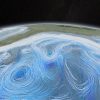Earth's Magnetic Oceans
You might hear a lot about the ocean’s magnetism, in a metaphorical sense that is. But, while people love flocking to the beach or setting sail, other forces are at work. It turns out the ocean’s magnetism might be much more literal than we think! Researchers now believe that Earth’s ocean may actually play a significant role in the planet’s magnetic field.
Why Do We Even Need a Magnetic Field?
But before we dive in, let’s back up for a second. Earth’s magnetic field is absolutely crucial to sustain life on the planet. Harmful radiation is emitted from the sun in the form of solar wind. This “wind” makes a beeline for anything revolving around the sun. Planets like Mercury that have no magnetic fields are quickly zapped into sterility. Because Earth’s core is made of mostly iron, the planet is itself ferromagnetic, but this is not the only aspect driving the planet’s magnetic field. That’s where oceans come back in.
The Big Blue Marble
Oceans make up 70% of Earth’s surface. With their tides and currents, oceans are capable of drastically affecting and altering the course of the planet. One way they do this is through generating their own magnetism. But how does it do this?
Saltwater, constantly ebbing and flowing with the tide, creates an electric current all around the planet. This electric current attracts magnetic fields deep below Earth’s crust, in the mantle. This was always the theory, at least. It turns out scientists got this one right! Mapping and imagery from the Swiss Federal Institute of Technology revealed that Earth’s oceans really are producing a magnetic field of their own!
Other Effects
While scientists don’t think this accounts for much of the planet’s magnetic field, they recognize that it is certainly a crucial factor. However, there is another effect of our oceans’ magnetism that deals with a completely different type of science—geology.
With data received from satellites and the proof that oceans generate their own magnetism, scientists have begun postulating that this might aid in studying plate tectonics. Continents and the rest of Earth’s crust sit on plates that move around the surface of the globe. While this is most likely due to geothermal activity, scientists are suggesting the ocean’s magnetism might also be playing a role.
While the ocean’s magnetic field is not yet fully understood, research is promising and who knows what discoveries will come next! Make sure to keep visiting our blog for all the latest breakthroughs and news!

